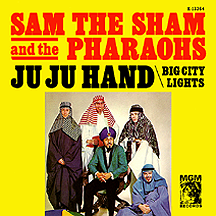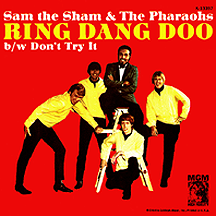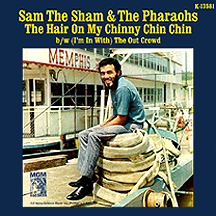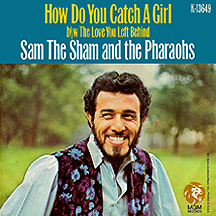SAM THE SHAM
AND THE PHARAOHS
I've heard the question about Sam the Sham's professional name come up more than once: was he really a sham? He's admitted to his vocal limitations, that he can't play more than five chords on the organ and has a tendency to clown around onstage. He and the guys in his group weren't Egyptian as their costumes would suggest, nor had they any middle eastern background. Those first three traits wouldn't really qualify as deceptions; the last might, but come on, we were all in on the joke! If there was even a hint of a sham, it was in promoting the band as having "The Memphis Pharaoh Sound"...since they were actually from Dallas, Texas and had spent minimal time in Tennessee. In reality, Sam the Sham and the Pharaohs were authentic, a raw and rockin' band, the nitty gritty, a seriously funtime assemblage. And who cared if no one really knew what, if anything, "Wooly Bully" meant?
The song had no real message. It was simply a hot, uptempo Tex-Mex party song. Wooly Bully, strangely enough, was the name of Sam's cat, and he just made up the rest of the song from there. The line 'let's not be L7' may be where the symbol "L7" (translation: square, as in un-hip) reached its peak as a popular slang term. It also didn't hurt that some of the lyrics are nearly unintelligible; after all, The Kingsmen's "Louie Louie" had been a major hit in spite of (or because of) its FBI-investigated dirty words. If the same thing helped get Sam the Sham on the charts, so be it. Nationally the record hit number two in June 1965 and was one of the year's biggest sellers; the band also picked up a Grammy nomination in the not-surprisingly specific category of Best Contemporary Rock and Roll Performance by a Group (Vocal or Instrumental).
The big breakthrough hit had come about after several years of trial-and-error. In the early 1950s, Domingo Samudio was in a group with a few of his high school friends, including Trini Lopez. Influenced by Yul Brynner's portrayal of Pharaoh Ramses in the 1956 blockbuster The Ten Commandments and impressed by his jaunty Egyptian robes, Samudio fronted a new group called The Pharaohs in the early '60s and took the tongue-in-cheek stage name Sam the Sham. After several personnel changes, the group was set with Ray Stinnet on lead guitar, Butch Gibson on saxophone, David Martin on bass and drummer Jerry Patterson backing up Sam's vocals and keyboards. The band's first single was a remake of the 1957 Chuck Willis gem "Betty and Dupree," on the Tupelo record label, owned by Jumpin' Gene Simmons. Their take on "Haunted House," originally recorded by Johnny Fuller in 1958, was released on the small Dingo label but ended up competing unsuccessfully with a version by Simmons, who scored a hit with the song just before Halloween in 1964. Before any concern could set in, a contract for the Pharaohs with MGM led to that spring '65 Wooly-Bully-blastoff.
The song, recorded in the wake of "Haunted House," was released on XL, then became the first single for MGM. Suddenly everyone knew who Sam the Sham was, even if they didn't understand this "Wooly Bully" mess he was shouting about. After that, the lyrics got a little clearer but still didn't make much sense. The next two singles took on the subject of superstition; Sam's "Ju Ju Hand" suggested a voodoo spell that 'makes your eyes look red and your tongue turn green' and warned that it was 'the strongest mess that you ever seen.' "Ring Dang Doo" (penned by Nashville songwriters Joy Byers and Bob Tubert) was even more vague, suggesting a search for something completely intangible: 'I don't know what it looks like, or what it can do...I got to find that ring dang doo!' Both songs were solid rockers with great screamin' vocals by Sam; the gabble of the lyrics just added to the fun and sent both follow-ups into the top 40. By late 1965 the group was spreading "Pharaoh-ization" from coast to coast, adding to the ju ju image by arriving at gigs in a black 1952 Hearse.
After three hits, the superstition theme had played itself out but would be revisited a year or so later. The band recycled another '50s R&B gem for their next single. Billy "The Kid" Emerson's "Red Hot" has been interpreted by many artists over the years, its lyrical girlfriend-on-display oneupmanship ('My gal is red hot...your gal ain't doodly squat!') proving irresistible to a variety of music acts. Emerson's is the definitive version, but Sam's rates as one of the best of the rest. A major change in the Pharaohs lineup happened at about this time when the entire group quit in a dispute over money owed them. Sam began again with the new lineup of guitarist Andy Kuha, sax player Frank Carabetta, bassist Tony Gerace and drummer Billy Bennett. They were not the tight outfit the earlier band had been, but were acceptable as they happened to come along when the Sham shifted into a less-rocking phase.
The subject matter of the next three Pharaohs singles took a turn some would consider not for the better. The first, "Lil' Red Riding Hood," put Sam square in the middle of the famous fairy tale, in the role of the Big Bad Wolf. Only this time instead of making plans to serve her up for dinner, the wolf is in love with Red but lacks the courage to tell her so (yet he keeps his 'sheep suit' on...very suspicious!). The song was an instant smash, sending Sam back to the number two spot in July 1966. MGM even released an answer version by girl group The Shamettes, "(Hey There) Big Bad Wolf," which didn't chart but would lead to something bigger for the trio.
Staying with the formula, Sam retained the persona of the wolf, this time terrorizing the Three Little Pigs in "The Hair on My Chinny Chinny Chin," another top 40 hit. The record's flip, "(I'm in With) The Out Crowd" (the reverse of a claim made by Dobie Gray a year or so earlier) was declared with the self-assurance that "out" was now "in." If "How Do You Catch a Girl" sounded more conventional based on the title, it was a ruse; the notion of using a fishing lure to attract a member of the opposite sex (to add to his collection of frogs, snakes and earthworms) clearly found him still on the familiar novelty wavelength. Written by Ronald Blackwell (as "Little Red" and "Chinny Chin Chin" had been), it was the last of six top 40 hits, a solid run on the charts over a two-year period.
The group backpedaled after this, playing the superstition angle again with "Oh That's Good, No That's Bad," suggesting that when something bad happens it leads to something good and vice versa...that is, until you end up on the receiving end of a botched operation. The fairy tale world was tapped one last time in mid-1967 with "Black Sheep" (a song by fellow Texan Bob McDill), a folkier groove with a hook straight from the original nursery rhyme ('have you any wool?...Three bags full!'). While not technically novelty songs, Sam the Sham's hits weren't completely serious either, but all of them were and still are fun to listen to, with the early efforts holding up best.
The hits stopped in '67, but a few more records were released and the band continued performing extensively, adding the Shamettes to the stage shows billed for a time as The Sam the Sham Revue. When MGM dropped the act near the end of the decade, Sam continued as a solo act, hitting a high mark with the 1971 Atlantic album Sam Hard and Heavy (featuring The Sweet Inspirations, The Dixie Flyers and guitarist Duane Allman on the session). His acknowledgements on the back cover, essentially a long and cleverly revealing list of thank-yous, won Samudio a Grammy award for Best Album Notes.
Some years ago I read an article wherein the writer said he wanted the world to know that there was more to '60s music than The Beatles, Bob Dylan and Sam the Sham and the Pharaohs. I liked that he had included Sam in the "big three." Was it intended as a joke? Probably. But the comment has stuck with me all these years, because Samudio and his hitmaking band are a good representation of an important facet of 1960s rock and roll.
NOTABLE SINGLES:
- Haunted House - 1964
- Wooly Bully - 1965
- Ju Ju Hand - 1965
- Ring Dang Doo - 1965
- Red Hot - 1966
- Lil' Red Riding Hood - 1966
- The Hair on My Chinny Chin Chin /
(I'm in With) The Out Crowd - 1966 - How Do You Catch a Girl - 1967
- Oh That's Good, No That's Bad - 1967
- Black Sheep - 1967
- Banned in Boston - 1967
as Sam the Sham - Yakety Yak - 1967
as Sam the Sham - I Couldn't Spell !!*@! - 1968
as Sam the Sham





